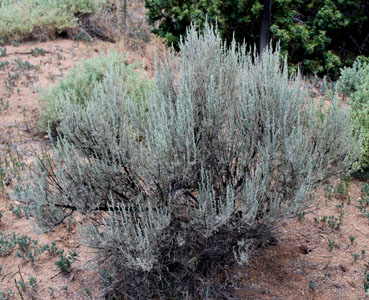Food:
"(Artemisias) --- have been used occasionally as a spice with meat or corn. --- The seed-like fruits have been eaten fresh, dried or pounded into meal." (Dunmire and Tierney 172)
Medicine:
"Nearly all species are intensely bitter and strongly aromatic, making them useful either to stimulate sweating in dry fevers or for indigestion and stomach acidity. A classic stomach tonic and bitter tonic. In addition, the hot tea (rounded teaspoon to a cup of water) has a stimulating effect on uterine circulation and will help in suppressed, crampy menstruations, particularly following illness or some emotional or physical trauma. As the name signifies, Wormwood will help expel or at least inhibit roundworm and pinworm infections, the secret being constancy, with at least tow cups a day for a period of a week or two. (Moore 162)
"The leaves are powdered and given to expectant mothers with a little water, and the same dose is administered to expel the afterbirth." (Curtin 110 )
"The leaves were dried, crushed and used snuff to relieve congestion, nose bleeds and headaches. --- Northern-wormwood tea was taken to relieve difficulties with urination or bowel movements, to ease delivery of babies and to cause abortions. --- Chewed powdered sage leaves were often applied to cuts, sores and blisters, and they have been shown top have anti-bacterial properties."(Kershaw 172)
Other Uses:
"Sage plants and smudges repel insects, and these aromatic herbs were also believed to drive away evil. They were widely used in religious ceremonies, both in smoking mixtures and as incense for purifying implements and people. ---- The pulverized roots of northern wormwood were used as perfume." (Kershaw 172)
"The principal uses of these plants are medicinal, largely owing to aromatic oils, including camphor, contained in sagebrush leaves. --- The leaves could also be chewed directly, as at Cochiti and San Ildefonso, inducing vomiting and thus emptying the system of whatever might be causing the problem.
With its camphor content, sagebrush has been highly valued in treating colds and coughs. Even today at Zuni big sagebrush is boiled in water and the steam inhaled as a decongestant; at San Juan Pueblo warm leaves may be applied to the neck to help a sore throat.(Dunmire and Tierney 151-2)
